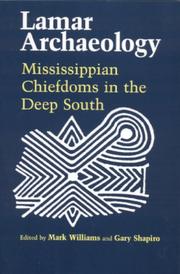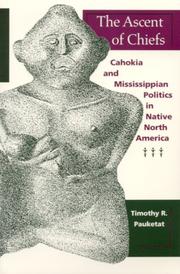| Listing 1 - 10 of 56 | << page >> |
Sort by
|
Book
ISBN: 9070110458 Year: 1985 Publisher: Leiden Rijksuniversiteit Leiden
Abstract | Keywords | Export | Availability | Bookmark
 Loading...
Loading...Choose an application
- Reference Manager
- EndNote
- RefWorks (Direct export to RefWorks)
Chiefdoms --- -Chieftaincies --- Chieftainships --- Political anthropology --- Africa --- Politics and government. --- -Africa --- Chieftaincies
Book
ISBN: 1283197758 995671514X 9786613197757 9956715263 995661632X 9789956715268 9789956616329 9789956616138 9956616133 Year: 2010 Publisher: Bamenda [Cameroon] : Langaa Research & Pub. Common Initiative Group,
Abstract | Keywords | Export | Availability | Bookmark
 Loading...
Loading...Choose an application
- Reference Manager
- EndNote
- RefWorks (Direct export to RefWorks)
The extremely irritable and quick-tempered chieftain, Akendong II has 14 children, all girls, and is saddened by the fact that he has no chopchair, a male heir to his throne. Then news comes to him that his favourite wife has given birth to a pair of twins, boys. He is even more angered by the fact that he has two heirs, a source of trouble for his kingdom. To avoid his wrath, his councillors change the story, sending away one of the boys to grow in hiding. Learning of the truth about his birth 15 years afterwards, the prince in hiding returns, kidnaps the palace prince and demands his full sh
Twins --- Inheritance and succession --- Chiefdoms --- Chieftaincies --- Chieftainships --- Political anthropology --- Africa
Book
ISBN: 9781139549547 1139549545 9781139059022 1139059025 1283610566 9781283610568 9781139552042 113955204X 9781139554503 1139554506 9781107015630 1107015634 1139564358 1139887459 9786613923011 1139550799 1139555758 Year: 2012 Publisher: Cambridge ; New York : Cambridge University Press,
Abstract | Keywords | Export | Availability | Bookmark
 Loading...
Loading...Choose an application
- Reference Manager
- EndNote
- RefWorks (Direct export to RefWorks)
This book tracks the development of social complexity in Ireland from the late prehistoric period on into the Middle Ages. Using a range of methods and techniques, particularly data from settlement patterns, Blair Gibson demonstrates how Ireland evolved from constellations of chiefdoms into a political entity bearing the characteristics of a rudimentary state. This book argues that early medieval Ireland's highly complex political systems should be viewed as amalgams of chiefdoms with democratic procedures for choosing leaders rather than kingdoms. Gibson explores how these chiefdom confederacies eventually transformed into recognizable states over a period of 1,400 years.
Chiefdoms --- Chieftaincies --- Chieftainships --- Political anthropology --- History. --- Ireland --- History --- Politics and government --- Social Sciences --- Archeology
Book
ISBN: 1282539914 9786612539916 0253004071 9780253004079 9780253354181 0253354188 9780253221551 0253221552 Year: 2010 Publisher: Bloomington, Ind. : Chesham, Indiana University Press ;
Abstract | Keywords | Export | Availability | Bookmark
 Loading...
Loading...Choose an application
- Reference Manager
- EndNote
- RefWorks (Direct export to RefWorks)
As South Africa consolidates its democracy, chieftaincy has remained a controversial and influential institution that has adapted to recent changes. J. Michael Williams examines the chieftaincy and how it has sought to assert its power since the end of apartheid. By taking local-level politics seriously and looking closely at how chiefs negotiate the new political order, Williams takes a position between those who see the chieftaincy as an indigenous democratic form deserving recognition and protection, a
Chiefdoms --- Local government --- Democracy --- Post-apartheid era --- Chieftaincies --- Chieftainships --- Political anthropology --- South Africa --- Social conditions --- Politics and government
Book
ISBN: 1928314554 1928314546 Year: 2019 Publisher: [Place of publication not identified] : African Sun Media,
Abstract | Keywords | Export | Availability | Bookmark
 Loading...
Loading...Choose an application
- Reference Manager
- EndNote
- RefWorks (Direct export to RefWorks)
Social history. --- Chiefdoms --- Chieftaincies --- Chieftainships --- Political anthropology --- Descriptive sociology --- Social conditions --- Social history --- History --- Sociology --- Mda, Mda,
Book
ISBN: 1281988332 9786611988333 9048506581 9087280521 9789048506583 9781281988331 9789087280529 9790000000000 Year: 2008 Publisher: [Amsterdam] : Leiden University Press,
Abstract | Keywords | Export | Availability | Bookmark
 Loading...
Loading...Choose an application
- Reference Manager
- EndNote
- RefWorks (Direct export to RefWorks)
Traditional authority is a distinguishing feature in the landscape of contemporary Africa. It remains important in organising the life of the people at the local level despite modern state structures. And since the 1990's, African governments, international institutions and donor organisations have shown a renewed interest in it. As a result, a large number of African countries have enhanced or formalised the position of their chiefs. At the same time, however, this resurgence of traditional authority coincides with the wave of democratisation across sub- Saharan Africa, and many question the desirability and legitimacy of traditional authority in modern forms of governance.
Africa -- Politics and government -- 1960. --- Chiefdoms -- Africa. --- Tribal government -- Africa. --- Chiefdoms --- Tribal government --- Africa --- Politics and government --- Chieftaincies --- Chieftainships --- Political science --- Tribes --- Political anthropology

ISBN: 0817383859 0585323380 9780585323381 9780817383855 0817304665 9780817304669 Year: 1990 Publisher: Tuscaloosa : University of Alabama Press,
Abstract | Keywords | Export | Availability | Bookmark
 Loading...
Loading...Choose an application
- Reference Manager
- EndNote
- RefWorks (Direct export to RefWorks)
A Dan Josselyn Memorial Publication Lamar Archaeology provides a comprehensive and detailed review of our knowledge of the late prehistoric Indian societies in the Southern Appalachian area and its peripheries. These Lamar societies were chiefdom-level groups who built most of the mounds in this large region and were ancestors of later tribes, including the Creeks and Cherokees. This book begins with a history of the last 50 years of archaeological and historical research and brings together for the first time all the available data on this early culture
Chiefdoms --- Indians of North America --- Lamar culture. --- Chieftaincies --- Chieftainships --- Political anthropology --- Lamar phase --- Mississippian culture --- Mound-builders --- Antiquities. --- Antiquities --- Southern States
Book
ISBN: 0820345776 9780820345772 9780820344980 0820344982 Year: 2013 Publisher: Athens, GA : University of Georgia Press,
Abstract | Keywords | Export | Availability | Bookmark
 Loading...
Loading...Choose an application
- Reference Manager
- EndNote
- RefWorks (Direct export to RefWorks)
From approximately AD 900 to 1600, ancient Mississippian culture dominated today's southeastern United States. These Native American societies, known more popularly as moundbuilders, had populations that numbered in the thousands, produced vast surpluses of food, engaged in longdistance trading, and were ruled by powerful leaders who raised large armies. Mississippian chiefdoms built fortified towns with massive earthen structures used as astrological monuments and burial grounds. The remnants of these cities-scattered throughout the Southeast from Florida north to Wisconsin and as far west as
Mounds --- Chiefdoms --- Mississippian culture --- Barrows --- Tumuli --- Archaeology --- Landforms --- Tombs --- Temple Mound culture --- Indians of North America --- Mound-builders --- Chieftaincies --- Chieftainships --- Political anthropology --- Antiquities --- Southern States --- Antiquities.

ISBN: 0817384189 0585193541 9780585193540 9780817384180 0817307281 9780817307288 Year: 1994 Publisher: Tuscaloosa : University of Alabama Press,
Abstract | Keywords | Export | Availability | Bookmark
 Loading...
Loading...Choose an application
- Reference Manager
- EndNote
- RefWorks (Direct export to RefWorks)
This ambitious book provides a theoretical explanation of how prehistoric Cahokia became a stratified society, and ultimately the pinnacle of Native American cultural achievement north of Mexico. Considering Cahokia in terms of class struggle, Pauketat claims that the political consolidation in this region of the Mississippi Valley happened quite suddenly, around A.D. 1000, after which the lords of Cahokia innovated strategies to preserve their power and ultimately emerged as divine chiefs. The new ideas and new data in this volume will invigorate the debate surrounding one of the mo
Chiefdoms. --- Mississippian culture. --- Chieftaincies --- Chieftainships --- Political anthropology --- Temple Mound culture --- Indians of North America --- Mound-builders --- Antiquities --- Cahokia Mounds State Historic Park (Ill.) --- Cahokia Mounds (Ill.) --- Cahokia Site (East Saint Louis, Ill.) --- Illinois

ISBN: 0817383085 0585140790 9780585140797 9780817383084 0817306722 9780817306724 Year: 1993 Publisher: Tuscaloosa : University of Alabama Press,
Abstract | Keywords | Export | Availability | Bookmark
 Loading...
Loading...Choose an application
- Reference Manager
- EndNote
- RefWorks (Direct export to RefWorks)
A Dan Josselyn Memorial Publication Within the last 50 years archaeologists have discovered that around the 10th century A.D., native southeastern peoples began a process of cultural change far more complex than anything that had occurred previously. These late prehistoric societies-known as Mississippian-have come to be regarded as chiefdoms. The chiefdoms are of great anthropological interest because in these kinds of societies social hierarchies or rank and status were first institutionalized. Ancient Chiefdoms of the Tombigbee focuses
Chiefdoms --- Mississippian culture --- Chieftaincies --- Chieftainships --- Political anthropology --- Temple Mound culture --- Indians of North America --- Mound-builders --- Antiquities --- Tombigbee River Valley (Miss. and Ala.) --- Lubub Creek Mound (Ala.) --- Tombigbee Valley (Miss. and Ala.) --- Lubub Creek Site (Ala.) --- Alabama --- Antiquities.
| Listing 1 - 10 of 56 | << page >> |
Sort by
|

 Search
Search Feedback
Feedback About UniCat
About UniCat  Help
Help News
News